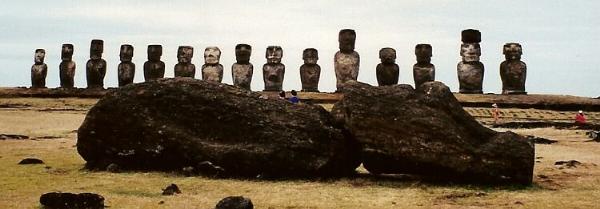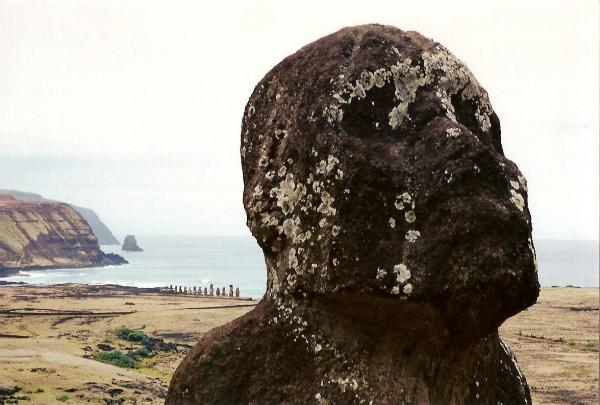This is not only the most remote place in the world, 1,700 miles away from the next inhabited island and 2,200 miles away from the main land, but also one of the world’s most exiting and most inspiring national parks.
Rapa Nui, the indigenous name of Easter Island, bears witness to a unique cultural phenomenon. A society of Polynesian origin that settled there c. A.D. 300 established a powerful, imaginative and original tradition of monumental sculpture and architecture, free from any external influence. From the 10th to the 16th century this society built shrines and erected enormous stone figures known as moai, which created an unrivalled cultural landscape that continues to fascinate people throughout the world.
There is a well researched, extensive description at Wikipedia, so I will not bore you with the details here but rather share the feelings and impressions I had while visiting this awesome place. Here is a short story I wrote after my visit:

It was the End of the World, as they knew it
Easter Island - The Fall and Rebirth of a Polynesian Culture
Imagine the entire world, stripped of all resources and hopelessly overpopulated. Imagine a civil war, lasting for three generations, completely destroying the cultural heritage of your people and burning every single written record of your past. Imagine a world after a worst-case environmental disaster with no trees, no water, no food and no place to go.
It already happened. It happened 200 years ago, and nobody noticed it. It happened on a tiny island, 15 miles in diameter, 2,400 miles off the coast of South America and 1,200 miles away from the next tiny island. But for those who lived there, it happened to the entire world as they knew it.
They were isolated for 57 generations, firmly believing they were the only people in the universe. Nothing ever changed their view; nothing ever interfered with their way of life. For almost 2,000 years, they took everything for granted. But then, their population outgrew the resources of their microcosm and more and more trees were cut for building material and firewood. And with the forest disappeared the rain clouds and with the rain disappeared the food. And when the last tree was felled they couldn't even build a ship to get away from it all and went to war over a bowl of rice. Within only 100 years, their entire culture had crumbled.
In the 1700s, when the first Europeans arrived, the remaining locals - weakened from 100 years of civil war - were easy prey. What little was left after the war was destroyed by devastating slave raids that took the lives of thousands. In 1870, only a hundred people were left on the island; an enigmatic pacific culture was smashed, ancient wisdom was gone for ever.
Slave raiders were not the only foreign invaders. With their ships came rats, cats and non-native seeds. The island - pushed to its limits for centuries - didn't have much power to resist. Can it get any worse? Just wait! In the late 1800s, the island became the property of the Chilean Navy, and thought with good intention, the navy got rid of what was left.
They planted trees; good idea, wrong method: it was Eucalyptus they planted. With virtually no resistance, this aggressive plant invaded the island like a gang of bloodthirsty pirates, killing whatever native plant was left. Still not bad enough? The Navy tried to solve the rat problem. In their infinite wisdom they introduced hawks! Well, the rats are still there and doing fine, but Manu Tara, the sacred native bird is all but extinct.
Fortunately, today things are going a lot better. Tourism has boosted the local economy, and with a better economy came better education and higher awareness of a unique cultural and environmental heritage. Of course, the island has captured the world's imagination long before it became a tourist spot, but things didn't change much as long as the only life line to the main land was one navy ship a year. It was not until the 1980s, that things really changed. Last in a chain of non-native invaders was NASA. And surprisingly enough, that invasion turned into a happy ending after all. NASA built an emergency runway for space shuttles. No shuttle has landed there yet, but twice a week a Jumbo Jet on its way from Santiago de Chile to Tahiti now touches ground on this 2.6 (!) mile concrete strip, bringing about a hundred tourists on every trip. Just a couple of days before the turn of the millennium, I was amongst them. For five days, I enjoyed Polynesian hospitality, admired 20 feet tall Moai statues, listened to stories and songs, and shared the sadness about the island's past and the optimism about its future.
Last Sunday, I went to a beach cleanup with a group of friends. And while we were sitting in a pile of plastic waste, beer cans and cigarette butts, I told them about my trip and I couldn't help comparing that tiny green island in the middle of a vast ocean with this tiny blue planet in the middle of a vast universe.
Maybe some day, after our world sadly shared the tiny island's fate, some alien discoverers will reach this little blue ball of ours at the outer rim of the western spiral arm of the galaxy. Alien archeologists will try to decode Navajo petroglyphs and will wonder who built the pyramids. Alien biologists will collect petrified Monterey Pinecones and will wonder what happened to the Grizzly Bear. And the last remaining earthlings will tell those aliens the sagas of rise and fall of the human race and will have no answer to the question "How could you ever let this happen?"
Still, there is hope. I have learned something on Easter Island: There is always a chance to turn things around. Today, people on Easter Island sift volcanic ashes in search of native seeds. They have successfully re-introduced 17 different native species, have rebuilt a dozen archeological sites, have turned more than half of their island's territory into a national park and voted against the construction of a major cruise ship harbor. They call their island by its local name and wear t-shirts saying "Proud to be Rapa Nui!" They have a lot of reasons to be proud of it!
